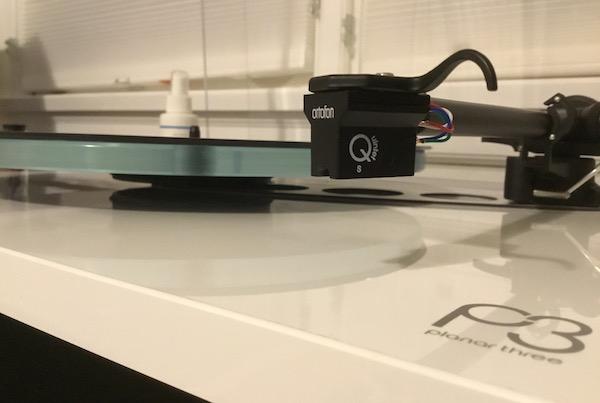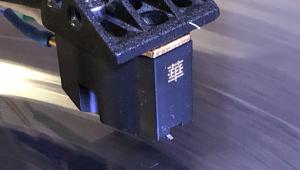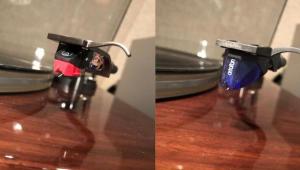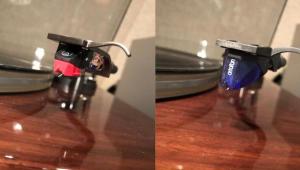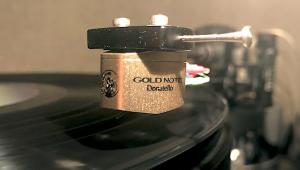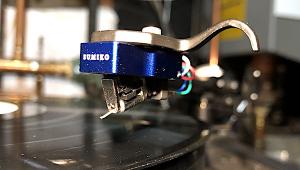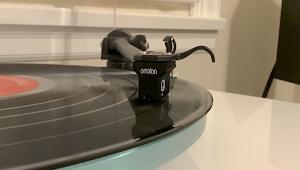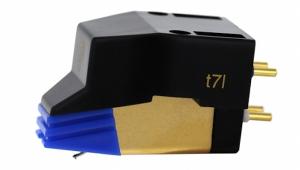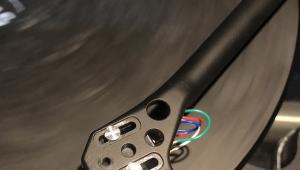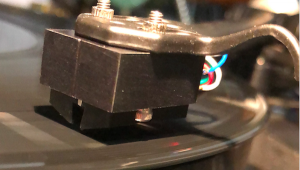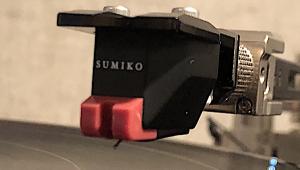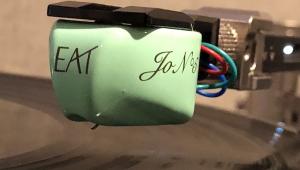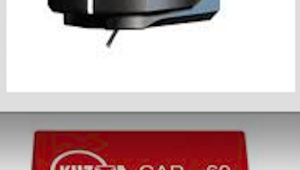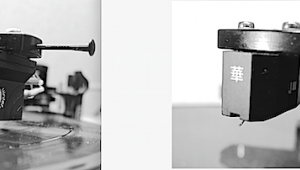But have opted for the Goldring Elite LOMC for $752.00. Let it play a little longer, or experiment with the arm height if not happy. Good review.
Malachi’s First MC Cartridge: Ortofon’s Quintet Black S
No more than a week later, a review sample of the Quintet Black S arrived at my house, but without having the setup tools or MC-compatible phono preamp, it sat in its box for weeks. Once I obtained Mobile Fidelity Electronics’ $499 UltraPhono phono preamp/headphone amp and the late Wally Malewicz’s Wallytractor overhang gauge, I finally installed the cartridge.
Features
As with Ortofon’s 2M series of moving magnet cartridges and their more expensive MC Cadenza line, the $999 Quintet Black S tops the MC Quintet series. It features a sapphire cantilever and Shibata stylus, tracks between 2.1-2.5 grams (2.3 grams suggested) VTF, and weighs 9 grams. Originally, the cartridge (like the one reviewed in 2014 by Michael Fremer) used a boron cantilever, but Ortofon changed it to sapphire when there was said to be a boron cantilever shortage (hence the “S” now appended to the name). Ortofon’s specifications list the output voltage at 0.3 mV, internal impedance at 5 ohms, and the recommended load impedance at greater than 20 ohms.
The box includes a flat head screwdriver, mounting screws, a plastic VTF gauge, and an Ortofon-branded stylus brush. Ortofon suggests against using solvents for stylus cleaning, as it may damage the stylus cement, the cantilever, and the cartridge’s innards. In addition, the company suggests for the same reasons cleaning records only with an anti-static brush. Further, Ortofon advocates the use of their ST-7 step-up transformer and LH-4000 head shell for those who need such devices. Since the stylus assembly is non-removable, the company offers an exchange service for worn-out cartridges, but give little information other than to contact your local dealer.
Setup
Aligning the Quintet Black S was relatively simple, but the wide body made zenith angle adjustment for me harder than usual. It’s also extremely tall, so raising or lowering the tonearm may be necessary to accommodate the Ortofon. I used the provided mounting screws for mounting on the Rega RB330 tonearm, and the Lofgren alignment scheme on the Wallytractor. The bottom of the cartridge body appeared to be parallel to the record surface, which, assuming high build quality, is a good sign for proper SRA.I set the MoFi UltraPhono’s input impedance to 100 ohms and applied 60dBs of gain.
Listening
After initially installing the Quintet Black S, I wasn’t impressed. “This for $999?” While detailed, the Ortofon sounded dark and veiled at first, especially on muddy mixes such as Jack White’s Boarding House Reach (colored vinyl LP, Third Man Records TMR-540), but 10 hours of breaking in created a drastic change. Josh Tillman’s excellent Father John Misty album Pure Comedy (2LP, Sub Pop SP1200) stunned, with Tillman’s voice liquid and instruments presented with immaculate detail. Cymbals shimmered on “Two Wildly Different Perspectives,” drums were present on “A Bigger Paper Bag,” strings rich on the 13-minute epic “Leaving LA,” and acoustic guitars realistic on “Total Entertainment Forever.” I bought the album a week after release, and the Chris Bellman-mastered, RTI-pressed double LP remains one of my favorites, musically and sonically. I’ve heard it on two different turntables, three turntable mats, three phono stages, and now three cartridges. None have exposed the recording’s excellence in my experience more than the Quintet Black S, Rega Planar 3, Stein Music “Perfect Interface” carbon mat, and MoFi UltraPhono combination, which specifically demonstrates the album’s excellent production and black backgrounds.
Another record I played early in the review period was Kendrick Lamar’s brilliant 2015 album To Pimp A Butterfly (180g 2LP, TDE/Aftermath/Interscope B0023464-01). Initially, I only listened to “i” and “Mortal Man,” the latter of which’s deep bass sounded uncontrolled and soft. However, I played it again after breaking in the cartridge, listening to more of the album this time. Thundercat’s bass on “King Kunta” and “Mortal Man” was tight and the latter’s dialogue between Kendrick and a sampled Tupac sounded pure, complimented by quiet RTI vinyl. Additionally, the electronic snare drum during the intro of “Institutionalized” was startlingly “there,” and I’d never before heard Terrace Martin’s keys on “These Walls” sound as gentle as they did with this cartridge.
That being said, those accustomed to the sound of mid-priced MM cartridges may need time to adjust to the Quintet Black S’s sound. To me, Rega’s $295 Elys 2 MM cartridge sounded more “exciting” than the Ortofon at first, but I eventually came to appreciate the Quintet’s added nuance and purity.
Not only does the Quintet Black S enhance the sound of excellent recordings, it also reveals flaws in poor ones. When I first heard Mobile Fidelity’s One-Step remaster of Simon & Garfunkel’s Bridge Over Troubled Water (45rpm 2LP, MFSL UD1S 2-0004), I listened with the Elys 2 and the built-in MM phono stage of my Onkyo TX-8260 integrated stereo amp/receiver. I thought the record sounded fantastic. However, system upgrades changed my opinion: using the UltraPhono and the Quintet Black S, I can attest that this reissue only has surface-level detail and is spatially flat with shallow bass, clear yet buried acoustic guitars, and lifeless presentations of the title track, “So Long, Frank Lloyd Wright,” and “The Boxer.” Even “Cecilia,” with the extreme clarity of its drums, sounds as if it’s trying too hard to cover up a poor-sounding tape source. According to engineer and producer Roy Halee, the first-generation master was lost in 1970, and the details of the tape currently in use are unknown. I respect MoFi’s effort to extract as much sonic information as possible from the source, but the existing source simply isn’t very good. Given that Mobile Fidelity is careful to not label secondary source material releases as “Original Master Recordings”, I assume a later generation tape was labeled as the “original master” and given them to use.
For those of us who don’t want to switch to a mono cartridge to play mono records, the Quintet Black S tracks mono LPs better than I expected. I played my 80s UK mono repress of Beatles For Sale with -3N/-3N matrices, and found only the slightest hints of distortion during peaks. When I pressed the mono switch on the UltraPhono, I didn’t hear any differences. In comparison, the same record exhibited much more distortion on the Elys 2, which the mono switch eliminated. Hearing the Quintet Black S’s ability to track mono records has dried up any desire I had for a mono cartridge.
The only problem I have with the cartridge itself is the extreme width of the body. The outer lip of “domed” (slightly warped into a bowl-like shape) records scrape against the cartridge for a short period of time at the beginning of each side. Neither the records nor cartridge were visibly damaged, but the scraping sound is extremely annoying and disruptive to the listening experience.
Conclusion
Setup may be difficult and time-consuming for some, but the Ortofon MC Quintet Black S offers a detailed and fairly neutral sound for a more than reasonable price tag of $999. It tracks like a champ, and the simple and clean look will visually match most turntables and tonearms. Most importantly, the cartridge appropriately represents the music within the grooves, and is an excellent entry into the moving coil world for those who can afford it. Despite the minor issues I had with the Quintet Black S, I highly recommend it to those looking for a great all-rounder cartridge in this price range.
- Log in or register to post comments


The quintet blue? I sold my black and kept the blue as it sounded better to my ears. The Quintet Blue is half the price! Don’t believe all the hype of the Black!

A good informative review. However I think it is worthwhile pointing out that the Shibata stylus profile on the Ortofon Quintet Black really requires very accurate setup. Having an arm without any immediate means of adjusting its height makes this difficult and some of Malachi's initial reactions to the sound of the cartridge seem indicative of this.
Rega cartridges are typically 15mm high whereas Ortofons are, as mentioned in the review, higher. 18mm is typical ( e.g. the 2M range) although some Ortofons are as tall as 19.5-20mm. I am unsure of the Quintet range but am confident that the preset arm height of the Rega will be too low.
Eyeballing how level the cartridge is will not be a substitute for getting it right and the tiny dimensions of the stylus can allow for significant error in setup which may still look OK from a simple visual aspect.
Fortunately Rega do offer shims which are used to raise the arm pillar. Try a 2mm one to start. If the sound is too dark ( as remarked on in the review when first heard ) then the arm is probably too low. If harsh and/or bright it may be too high.
Coincidentally I actuall installed an Ortofon cartidge with a Shibata stylus ( 2M Mono SE) yesterday afternoon in an Audiomods arm which uses a Rega sourced armtube. My nitial presumed correct level setting of the arm by eyeballing only was way out in reality and I needed to lower (in this case) the arm a few millimetres, checking by ear, before the sound "popped" into correct balance.
I wonder if Razorball's preference for the Quintet Blue ( nude elliptical stylus, more forgiving in this aspect) stems from the same cause?

..will be very grateful. And thanks for bringing the Acoustic Signature shims to my attention. Also thanks for your talent spotting abilities in adding Malachi's reviews. I have heard of child prodigy violinists and pianists but this is my first for an audio and music reviewer.
Keeping on the subject of youth it is my godson's 14th birthday next month. He wants LPs and a system to play them on. Makes my heart sing. BTW, his wish will come true.

If Stereophile can find it in their budget perhaps an Audiomods tonearm that is basically a modified Rega tonearm that allows minute VTA adjustments. I am sure it would fit the Rega and allow for Malachi to zero in and optimize his reviews. Just a thought.

The Shibata stylus, is very finicky in terms of setup. It tracks well once done correctly. But with an arm where VTA can't be altered, it's going to be difficult for Malachi to accurately critique the sounds of albums. I find that, if I really want to be finicky myself, the difference between a 200gm profile LP and a 100gm profile LP can be significant enough to alter things like imaging, pace, air, etc. And it's not just the LP profile, but it's the angle at which the LP was cut, too, to my understanding.
I have a VPI Scout (and Benz-Micro M2 wood body). Its VTA adjustment is by a thumbscrew at the base of the tonearm. Let me tell you - just a few turns of the screw can subtly tamp down sibilance, or sharpen transient response, improve air, tighten the bass. Further turns renders more of a difference.
The Rega Planar 3 is a great sounding turntable and a great value, but it's not the best table for being an audio critic of LPs, I don't think. It's partly the lack of adjustability, and the somewhat lower level of detail that it renders absolutely. It's great at rhythm and rocking. Very satisfying in terms of the energy conveyed. But not the most critical of platforms, from my experience.
I think a line contact or elliptical such that is on the Ortofon Bronze or Blue might have been a better choice for that table.

Actual trolls only listen to YouTube-quality (192kbp/s) mp3s of Corey Feldman’s awful 2016 double album “Angelic 2 the Core.”

you're right...and I apologize to Jimmy Buffett, who has the sense to keep his shirt on.

Mikey, your gift of the shims is very cool. It will allow Malachi to get a better appreciation of the UD1S S&G pressing. I cannot even begin to agree with his assessment of that album.
I play it on a VPI Prime w/Unipivot 3D tonearm (2nd pivot assy), Ortofon Windfeld Ti cartridge, Audioquest Leopard phono IC, Bob's Devices Sky 30 stepup and Liberty B2B-1 phono preamp. That setup show the S&G UD1S to be what others have said.
It is a very good pressing and I wish they would have released it on the new SuperVinyl, but its great the way it is. I am really looking forward to Yes - Fragile on a SuperVinyl UD1S pressing. I have several reissues and a first US pressing of that album but I suspect the UD1S will be one of the very best of that title.
Ed

I was wondering about the SQ on the first side. The second side of that pressing (LP 2) sounds much better than the first. When I first spun the opening track it was not overwhelming. I know it had better sound than that but this was not what I was expecting.
Once I reached the second LP (side 2) the sound quality jumped up to another level. "Why Don't You Write Me" jumps off the LP. This was what I was expecting.
I guess I have become used to the differing SQ from the ageing master tapes. I'll make sure I hold onto my original pressings. Sometimes the reissues are great and sometimes they are as you explained.
Let us know how that Tampa Audio expo goes and how they react to the two different pressings.
Good luck and have a good flight,
Ed

Malachi, I'm so glad you have caught the analog bug. And your enthusiasm is great.
That being said, if you're experiencing thin sound a flat soundstage, you need to check your adjustments and/or equipment.
I have an original, the Classic Records 33, and the One-Step. On one hand, the One-Step shows both the greatness as well as the flaws in the recording in the mastering. On the other, this is the most liquid, most full- bodied, and most naturally fleshed out pressing. With the best sounding songs, such as Baby Driver and The Only Living Boy In New York, the sound is rich and complex, and the soundstage is deep and layered. Bass is deep and tuneful. It's a most analog sounding of recordings.
Sometimes Halee futzed around too much and it sounds over processed, such as El Condor Pasa.
But Song For The Asking is glorious for its simplicity, naturalness, and presence.
If you're not hearing that, there's something off with your equipment somewhere.

... (Planar 3 + Elys + Quintet Black S + UltraPhono), skip the new phono preamp and upgrade the turntable and cartridge.
For example, a Technics SL-1200/1210GR with either an Ortofon 2M Black or an Audio-Technica VM760SLC.
If you prefer belt drive, there's the MoFi UltraDeck with a MasterTracker cartridge.

It's already too late. The table was a gift. The cartridge has already been installed. The only thing he could do is return the phono preamp and sell the table and cartridge. Maybe he'll get $1200 for both on the slightly used market. That's a lot of dough to even get to what you're suggesting.

I’m perfectly happy with the Rega P3 - I think it’s an excellent turntable and there’s no need for me to do a full upgrade now. The Stein Music “Perfect Interface” Carbon mat makes a huge difference compared to the supplied Rega felt mat, and I can always change cartridges if I want. There are so many aftermarket Rega modifications out there that I can take it from a $945 TT to a $3,500 TT if I wanted to. I’m also happy with the UltraPhono - it sounds good and has the mono switch.

... and the Quintet Black S is a review sample that has to be returned, maybe you'd want to try a Rega Exact 2 cartridge. Its fine line stylus would be an improvement over the elliptical stylus in the Elys 2.

It IS a fine table. But if you're going to be a reviewer, you need to have a table/cartridge and associated electronics that are capable of detecting fine detail.
That you're finding the Bridge One-Step flat tells me that there's something not right with what's coming out of your speakers.
Someone else mentioned the phono stage. That could be a bottle neck as well.
Having an enjoyable system is different than having one good enough for reviewing. It's important that you get advice on having one that's truly an accurate as well as musical one.

Michael shares my opinion of the “BOTW” One-Step, for what it’s worth.
Also, don’t forget the ears. That’s probably the single most important part of reviewing. If you don’t have good hearing, your opinion isn’t worth much. You could have the best hearing in the world and review records on a $400 turntable, and you’re better equipped than a person with a $5,000 TT and mediocre hearing.

Agreed on the ears part. I'm fortunate to have been restored with a good pair of those.
I can only say that BOTW is not my favorite of the One-Steps because it shows the album's sonic flaws as well as its strengths. But if the cuts I mentioned aren't 'wows' for you or Michael, then you really need to recheck VTA or other setup parameters. I have a very good, revealing system. It's not up with Michael's, but it's very revealing. The soundstage on "Baby Driver" and "The Only Living Boy..." is not flat, for one. I don't think a system can generate a layered, deep soundstage, so it must be there in the recording. And the harmonic texture of this reissue surpasses previous pressings.
But I also think it reveals Roy Halee's at times over-production. It's hard to listen to "Frank Lloyd Wright" because of it.

I couldn't believe how much more I was hearing when I upgraded from an Acoustech PH-1 phono stage to my current Att Audio Vinyl One. There is SO much more color, more harmonic texture, far greater dynamics. The same music is MUCH more impactful. Images are larger. Soundstage is more layered and deeper.
With the lesser phono stage, it was, in hindsight, that lots of the sound was just not being conveyed.
So, in hindsight, I ponder about how I could fairly comment about a record if I wasn't nearly hearing everything on it. I could comment on I was hearing, but it was that upgrade that made me realize that in order to be critical, I have to have a system capable of revealing a significant degree of what's on the record.
That's why I distinguish an enjoyable system vs a critique worthy one.
I have a friend who was a professional audio critic with a national magazine. When he retired from that business, he swapped out his audio critic level equipment for a sound that was less accurate, but more fun for him. He knew that there's a difference between accuracy and enjoyable. Not that they're mutually exclusive, but he is a rock and roller at heart, and he wanted a system that rocked cit his personal listening, knowing it wasn't as accurate.

... Acoustech PH-1 and the Art Audio Vinyl One is the difference between op-amps and vacuum tubes.

I am going through the worst case of sinusitis and post-nasal drip I have ever endured in 54 years. I lost volume for a time, it's mostly come back but not all the fidelity has come back. For the first time in my life I get home from work and prefer to watch TV instead of listen to music. My daughter starts a choir tour next month and for the first time in my life I am not looking forward to it.

Hmm, no need for that really, I think the RP3 is a fine table. It is surprising how good even a $400 table can sound when dialed in and matched up well.

changing from MM to MC with a budget of less than $1000 is always frustrating. MM is rounder and more involving in comparison with cheap MC systems (sadly 1000 for MC is too cheap to give satisfying results). I tried several MCs and it would have been much wiser to stay with MM and wait until the budget allows for a cartridge of at least $1500. At this price range is a tilt towards the professional MCs and the hated S-sibilance gets under control. The only "cheap" cartridge not being an MM I could live with is a London Decca Gold, which can be very involving and revealing with a tubed preamp. I for myself now have a range of EMT monos and stereos and did not change them for years. A new MC will again be from EMT one day in the (hopefully) far future. On a TD 124 I settled 20 years ago after a disappointing Graham/Oracle Delphi combination. The TD 124 cost me 300 euros. Mounted is an old unipivot Haycock tonearm. Perfect to me. And analog heaven I get from the 2-track tapes played on my Revox machine.

Two different Ortofon dealers nudged me away from the Quintet line. They like the MM series for MM buyers, and they like the Cadenza series on up. I tried the 2M SE Mono and didn't like it (Colorful, but too chunky and oversaturated, not very nuanced). They think the Quintet series is not very musically involving.

Of course they would love you to buy the Cadenza instead of a Quintet, did you see the price difference? Never ever believe a hifi salesman, compare for yourself!

Nice, oh skeptical one. But that wouldn't explain their like for the MM line. And I was looking for a mono cartridge at the time. They encouraged me to seek out the 2M Mino SE, a cartridge that dealers didn't have access to.

I got the 2M Mono SE directly from the U.S. distributor.
I didn't care for it. I sold it for $450.

1000 dollars budget for a MC cart is perfectly fine,i have had carts like Zu 103 and AT ART9 and they didnt disappoint.No issues like sibilance too.

I’m betting that thin flat or lifeless sound the youngster is hearing is due to some more set up or dial-in work needed, I concur. Microline styli are a PITA to get right. That doesn’t make them bad, it just means a bit more work is needed, that’s all. It is also important to make sure the cart and arm are a match. I run a microline (Shibata stylus) on my table and it took me about an hour and a half start to finish, to get right and it was not my first rodeo either. Even though we are talking millimeters, ellipticals are more forgiving. I learned how to set up my tables before I even saw Michael’s videos and such. In my opinion, Michael is not only a master at table setup, but also does a great job at stressing the importance of learning to do it yourself and doing it right. Anyone who wants to get into analog should learn these things as mandatory. There is the side benefit of knowing you did it successfully when you get it right, it’s a good feeling. (By the way, there are also plenty of good MM carts as well. MC carts are not superior, just different in my view, Both are good).
In my opinion, I also think that there may be a bit “cart before the horse” in the setup, no pun intended. Putting a $1000 cart on an RP3 and only allotting a $500 preamp going into a AVR is like putting racing wheels on a Prius. It doesn’t address the bottleneck, only moves it. If it were me, I would have put that $1000 into a nice phono preamp before going to that length in a cart. One can do pretty good on the Phono preamp area for $1000 and even maybe have a nice left-over amount for more records. (Real nice phono preamps out there for both MM/MC that will best the MoFi one for around $700 and that includes ones with load adjustment).
Hmm, just a thought Malachi, does the MoFi preamp have adjustments? If so, you might want to experiment with that as another part of dialing things in.
I also would recommend considering saving up for a nice 2-channel amp situation. Doesn’t have to cost a fortune, there are some good decent integrated amps out there for well under four figures you could be happy with for a few years. This would effectively kind of clean up the signal path compared to everything but the kitchen sink in AVRs. Until recently, I was using a top shelf AVR myself that sounded lack-luster and very 2D because it had everything and a poorly implemented dac in my opinion. Even though I run a high-end phono pre into it, it still did not do well for 2 channel. In fact, I think the only reason the kitchen sink was not in it was because they ran out of room. (I now run a proper 2 channel system and the difference is literally night and day.
Just my penny thoughts.

To clear up confusion, my Onkyo TX-8260 is a two-channel audio-only receiver/integrated amp with a built-in DAC, network compatibility, and MM phono pre. Got mine for $300 last year and couldn’t be happier for the price. I’ve been looking into upgrades but it’s not a priority.

Oh, my apologies,that's covered then. Yes, I was a bit confused with all the talk of AVR in the first part of the article.

For those wondering, VTA was 90 degrees, so it was “in the ballpark” for measurements. I’m sure 92 degrees sounds better but I just want to clarify for those who think VTA/SRA is inaccurate.

The SRA being off even as little as 2 degrees is a very serious thing when you are using a stylus like a Shibata. Even small fractions of a degree make a difference when you are doing something like reviewing a LP. It really makes a difference.
The SRA being off just a little can tell the difference between an opinion of a great pressing or just an OK one. Please take that gift from Mikey and put it to good use.
Oh, and for the record, I am a proponent of VTA on the fly. Just so you understand the mindset I come from.
Ed
Ed

thanks for the info on the bridge over troubled water, i just bought a first copy,NM, for a dollar and it does sound great! just pulled it out and cleaned and vacuumed and disc record cleaned it..NM now.
God , the sound is really good!

Malachi;
I am sure your mentor has warned you but please please please don't put much stock in anything posted in the comments section, including this comment. Stick to what you are doing and always remember that nobody else was there to hear what you heard. Nobody else was there to align your cartridge. All attempts by others to explain your perceptions are pure speculation. Often, even engaging in conversation or responding to the comments section is an exercise of pure futility and frustration. FWIW, I own several Ortofon cartridges including the Quintet Black and Cadenza Bronze. I think your comments are pretty spot-on, and you didn't even have the benefit of comparison of multiple MC cartridges. All this said, I am a bit confused about your criticism of the wide body of the cartridge adversely affecting the ease of getting optimum alignment. IMO, the body of the Quintet is relatively narrow and further, the body should not affect your ability to see the zenith of the cantilever since you should be looking from the front and not the side. But no big deal. Keep it up and don't let anyone shake your confidence. I am still blown away by your knowledge of music and your writing ability; your review of the Coltrane hullabaloo is mind-blowing. And this will be sacrilegious to many, but IMHO VTF, azimuth, and zenith are more important than VTA. I have had multiple turntables with adjustable VTA on the fly and the effect is minor compared to the previously referenced parameters. I am not familiar with your choice of mat, but I would suggest setting VTA for a 150 gram record and then forget things until you change your cartridge. The few fanatics who list optimum VTA for each and every record they own clearly have issues.

if the master tapes are in such bad condition why bother with a fancy one-step re-issue ?
it's not exactly a rare record .

I could be wrong, but my guess is there's going to be a second review with that same cartridge once the teething problems are overcome.

Very grateful too read a review using Kendrick. Keep up the good work!

Play the exciting infinite skiing game Snow Rider 3D and test your skills and speed to the limit! Take a snow sled ride full of unexpected twists and turns for an exhilarating thrill adventure! Unlock new sleds by sliding down endless ice slopes while avoiding tough dangers and collecting glittering Christmas present boxes.
